When you’re a hockey player, your stick is like your best friend! In this hockey stick guide we will get you better acquainted with your soon to be best friend!
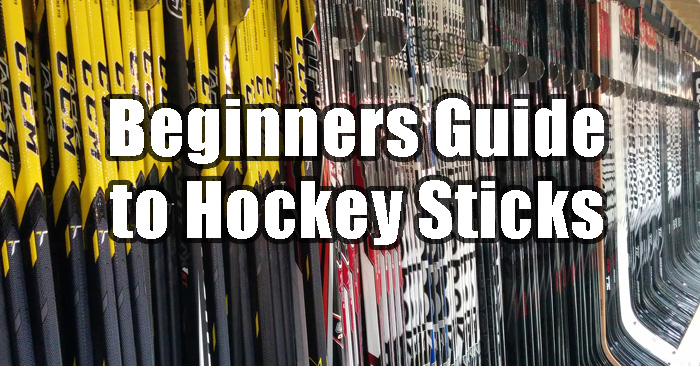
Hockey sticks, like skates, are considered to be one of the most important and personal pieces of equipment for players. Although you may only have the puck on your stick for a few seconds at a time during a game, you wan’t to make them count! With a stick there are a lot of variables like the company that makes it, the make and model, the weight, materials, height, flex, curve, lie and flex points. All of these aspects of a hockey stick will rely a little on your playing style, weight, height and position and a little bit on personal preference. Let’s start off with the different types of hockey sticks
Types of Hockey Sticks

There are several types of sticks to choose from since they’re made out of a variety of materials. The most common material is carbon fiber, or a mix of carbon fiber and other materials although you can still find wood, fiberglass or maybe even a used aluminum stick. There are also one and two-piece sticks available although one piece are the most common.
Wood

Wooden hockey sticks are typically the least expensive, although the cheapest wood sticks aren’t that great. They are fine for an entry level player on a budget, but for the price of a quality wood stick you could likely find a low to mid-range composite stick on sale for about the same price. People who still use wood sticks probably do so because they’re cheap, or prefer the feel.
Composite
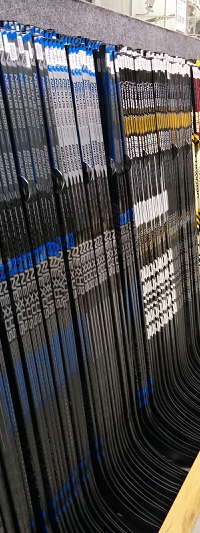 Almost every serious hockey player uses a composite stick these days. You can find them in one and two-piece models, although one-piece is almost exclusively used (a two piece stick allows for a composite shaft and wood blade). Composite sticks are more flexible than wood sticks, allow for pre determined flex ratings, and flex profiles like low, mid, or high kick points. Most players prefer one-piece sticks, but they can be expensive and they will still break. A common misconception is that the more you spend, the longer your stick will last. Usually with composite sticks the more expensive sticks are made of lighter material and can break faster, while the cheaper sticks are mixed with fiberglass (making them heavier, but more affordable) but will last longer.
Almost every serious hockey player uses a composite stick these days. You can find them in one and two-piece models, although one-piece is almost exclusively used (a two piece stick allows for a composite shaft and wood blade). Composite sticks are more flexible than wood sticks, allow for pre determined flex ratings, and flex profiles like low, mid, or high kick points. Most players prefer one-piece sticks, but they can be expensive and they will still break. A common misconception is that the more you spend, the longer your stick will last. Usually with composite sticks the more expensive sticks are made of lighter material and can break faster, while the cheaper sticks are mixed with fiberglass (making them heavier, but more affordable) but will last longer.
Types of Sticks:
Fiberglass
These are typically wooden sticks that are reinforced for strength by a fiberglass coating or wrapping. These were all the rage years ago as a more technically advanced wood stick, however they aren’t very popular now.
Aluminum
Aluminum sticks were the first non-wood hockey sticks to become popular. The shafts are constructed with aluminum while replaceable composite or wood blades are inserted into the shaft. The sticks were lighter and stronger than fiberglass and wood, but not as light as Kevlar and graphite. In my last 10 years of Men’s league hockey I’ve seen one or two aluminum sticks. No companies currently make them, and no pro players use them.
Carbon Fiber
Most high end sticks will be 100% carbon fiber. The majority of hockey sticks on the market today are made of either 100% carbon fiber, or a mix of carbon fiber and some other material. The cheaper sticks will generally be carbon fiber and fiberglass.
Kevlar
Kevlar is typically mixed with other materials or added as a layer to reinforce a certain part of the stick.
Reinforced

Colt Hockey has taken a Graphite stick, and dipped it in nano steel to reinforce the bottom half of the stick. Interested? Check out their site, and use coupon code HOWTOHOCKEY to save $20.
Quick video on How To Choose a Hockey Stick
https://www.youtube.com/watch?v=QZA15v7sOoY
Hockey stick Length, Lie, Weight, Curve and Flex
You get what you pay for
 When you’re shopping for a hockey stick there are four common price points. The guide below will help you understand what you’re paying for.
When you’re shopping for a hockey stick there are four common price points. The guide below will help you understand what you’re paying for.
- Around $50
- General – At this price point it will be hard to find a high end stick. You’ll be able to find wood sticks, and heavy composite sticks.
- Materials – The composite sticks at this price point will be mostly fiberglass mixed with some composite making them heavy and not as well balanced.
- Technology – You likely won’t find any advanced materials or methods used here
- Construction – These sticks will likely use two piece construction (blade and shaft made separately and then fused) and be made quickly (no extra care taken in how the composite sheets are layered)
- Feel – Heavier, not as well balanced, less puck feel (unless you use a wood stick, these are said to provide great feel)
- Around $100
- General – You should be able to find a decent stick at this price point. You’ll either find an entry level stick, or a mid range stick that’s on sale
- Materials – These sticks will use more carbon fiber, but still usually use a mix to save money
- Technology – You may find some older technology in these sticks, something that was cutting edge a few years ago, and now used in lower level sticks
- Construction – Typically at this level the sticks are still two pieces fused together to look like a one piece stick.
- Feel – Should be good, a little heavier, but some prefer a heavier stick
- Around $200
- General – You’ll find a good stick at this level. You can get last years top of the line stick on sale, or a companies 2nd tier stick that they purposely make just a little worse than their top of the line stick. The company will leave off one or two features, or have it a little heavier
- Materials – The material here should be close to 100% carbon fiber, the sticks should be light, but won’t be the lightest available
- Technology – The sticks may share some of the latest technology with this years top of the line stick, but won’t have it all. Advances are usually made in the carbon fiber, construction process, foam or gel used inside the blade, or shape of the shaft, blade or taper (where the blade meets the shaft)
- Construction – Most sticks here should be a true one-piece although some may not.
- Feel – Lighter, well balanced, good puck feel
- Around $300
- General – This is the top of the line price point for most stick companies, however some brands that aren’t as popular will offer something comparable at a lesser price. At this price point you’ll be getting the absolute best stick the company can offer you. The big companies like Bauer and CCM spend millions each year on research and development as well as marketing and branding. You pay for it when you buy the top of the line gear
- Materials – Most sticks will be 100% carbon fiber, or carbon fiber and another advanced material used to enhance the performance or feel. There are also different types of carbon fiber and new advances being made on the material, so typically the most advanced carbon fiber is used.
- Technology – Here you’ll find whatever latest breakthrough the company has made (or a cool buzz word to build hype). Usually companies will boast something that increases power, provides better feel, or better accuracy.
- Construction – Every stick at this price should be a true one piece stick. This makes for a more expensive stick because the companies need to create a new mold for every single curve pattern they offer both left and right handed. The entire stick is created at the same time allowing for better energy transfer.
- Feel – Very light, excellent puck feel and balance.
Stick Height
The length and weight of your stick is a personal decision. Some players prefer shorter and lighter shafts so they can stickhandle in cramped quarters and release their shots quicker while defensemen typically prefer longer and heavier sticks to check the opposition from a greater distance and clear out the front of the net. Your position and skating style may affect your preference. If you skate with a hunched-over style then a shorter stick may suit you better while upright skaters will be better off with a longer stick.
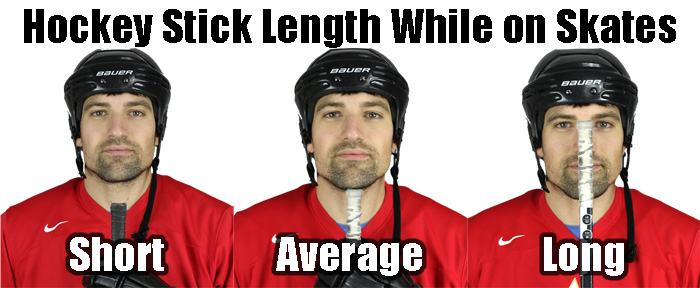
Note from coach Jeremy – A stick just below the chin is a good starting point for beginners, after you get comfortable play with the length of your stick and find something you like. NHL players use a variety of lengths from stick length, all the way up to the eyes!
According to some experts, the top of the stick should touch your chin when you’re on skates. But in reality, you need to find a stick that is comfortable, suits your style of play, and is productive for you regardless of the length, weight, type of curve, flex, and the hockey stick lie.
Hockey Stick sizes
It’s hard to handle the puck if your stick’s too short or long. Most manufacturers make sticks in two specific sizes, which are junior, and senior. Junior sticks are usually between 46 and 54 inches while senior models are from 56 to 63 inches. Shaft diameters range from Junior, Intermediate, and Senior. Most defensemen use longer sticks as they give them a longer reach for poke checks and intercepting passes and will help add a bit more power to the slapshot.
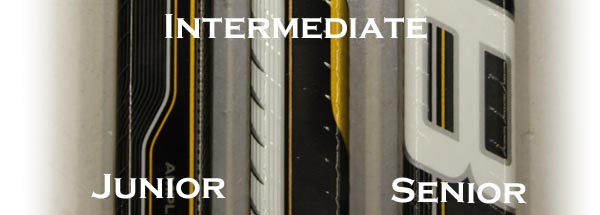
This video was made to help with picking sticks for kids, but the information is also helpful for players of any age
Hockey Stick Weight
Most forwards prefer lighter sticks for maneuverability as they enable you to pass and shoot quicker. Defensemen generally prefer heavier sticks for checking with, but still prefer composite models over wood since they’re more durable. Anything under 450 grams is pretty light!
Hockey Stick Curves
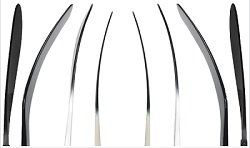 Hockey sticks are curved for right or left-handed players with very few blades being straight these days. The blade is either curved at the toe, middle, or heel of the blade, the one you choose is generally based on personal preference. For more information about picking the right curve we have an extensive article all about hockey stick curves
Hockey sticks are curved for right or left-handed players with very few blades being straight these days. The blade is either curved at the toe, middle, or heel of the blade, the one you choose is generally based on personal preference. For more information about picking the right curve we have an extensive article all about hockey stick curves
Hockey Stick Flex
The flex is the stiffness of a hockey stick’s shaft and higher numbers represent stiffer shafts. The rating (lets say 85 flex) is the amount of force required to flex a stick one inch, so an 85 flex stick will take 85 pounds of force to bend one inch. Usually I recommend starting with a flex that is half your weight. Defensemen and big, strong players typically use stiffer shafts while most forwards prefer more flex. Since you need considerable strength to shoot effectively with a stiffer shaft, they’re not really ideal for young children. Learn more in this hockey stick flex guide
Finding a hockey stick for kids
When shopping for hockey sticks for kids it can be hard to find a flex that matches their weight. Most stick flexes start at 40 and then the stick needs to be cut, which can alter the flex. If you’re looking for a flex that is properly matched to your kids weight check out Mode Hockey This is a company that I am a part owner of. The sticks are pro quality (100% carbon fiber) with low flex ratings.
|
Hockey Stick Flex/Length Chart |
||||
|
Age Group |
Height |
Weight |
Recommended Shaft Flex |
Stick Length |
| Youth (3-5) | 3’0″-3’10” | 30-65 lbs | 20-35 Flex | 38-44″ |
| Youth (6-8) | 3’10”-4’8″ | 50-80 lbs | 30-45 Flex | 45-49″ |
| Junior (7-13) | 4’4″-5’1″ | 70-110 lbs | 40-55 Flex | 50-54″ |
| Intermediate (11-14) | 4’11”-5’4″ | 95-125 lbs | 50-60 Flex | 55-58″ |
| Intermediate (12-14) | 5’2″-5’8″ | 100-140 lbs | 50-70 Flex |
55-58″ |
| Senior (14+) | 5’5″-5’10” | 125-175 lbs | 60-85 Flex |
57-61″ |
| Senior (14+) | 5’7″-6’1″ | 150-200 lbs | 70-110 Flex |
58-62″ |
| Senior (14+) | 5’10”-6’4″ | 180-235 lbs | 90-110 Flex |
60-63″ |
| Senior (14+) | 6’1+ | 210+ | 110+ Flex |
60-63″ |
Hockey Stick Lie
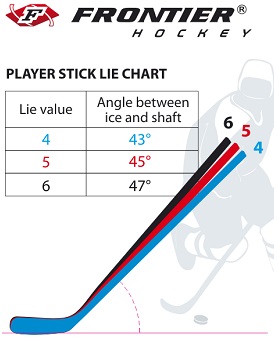 The lie of the hockey stick is the angle between the blade of the stick and the shaft. Most sticks will have a lie between 4 and 7 and each lie is a two-degree difference in the angle. For example, a 4 lie is 137 degree while a 5 lie is 135 degrees and so forth.
The lie of the hockey stick is the angle between the blade of the stick and the shaft. Most sticks will have a lie between 4 and 7 and each lie is a two-degree difference in the angle. For example, a 4 lie is 137 degree while a 5 lie is 135 degrees and so forth.
Lower lies are usually better for players who carry the puck out in front of them and skate lower to the ice. Higher stick lies are often used by those who carry the puck closer to their skates and skate upright. Basically, when standing on the rink you want the entire blade to be flat on the ice, not just the heel or toe.
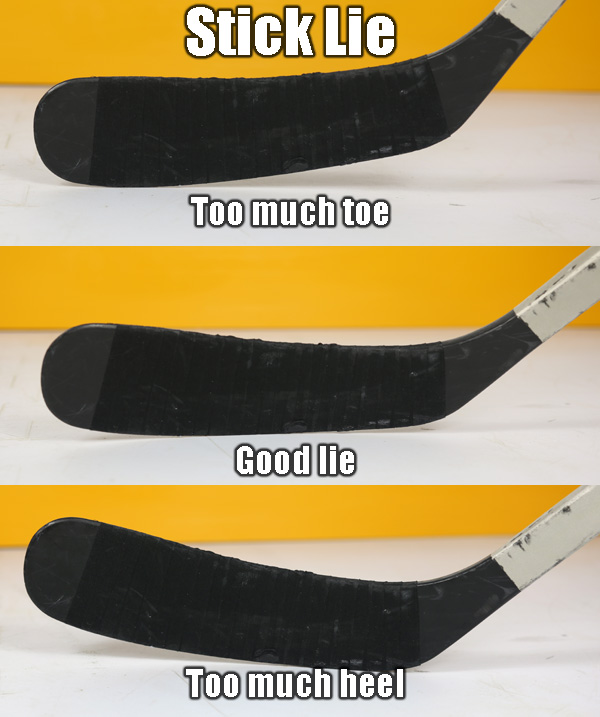
How To Tape a Hockey Stick
For more videos on taping your hockey stick see how to tape the blade and how to tape a hockey stick grip
Hockey Fitting Video
Video by: Pro Hockey Life
Recommended online stores for Hockey Sticks
- Pro Hockey Life
- Hockey Monkey
- Mode Hockey – They make sticks with appropriate flex and size for children
Learn to Play Hockey Online – Join The Pond for easy to follow video courses, challenges, and a private social group to quickly improve your hockey skills at home